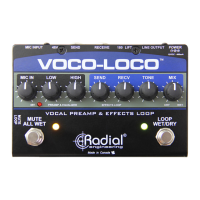Radial Engineering Ltd.
Voco-Loco™ Preamp Loop
True to the Music
®
7
USING THE VOCO-LOCO WITH VARIOUS EFFECTS
Adding distortion to a vocal or instrument
Adding distortion can be a lot of fun! Although you may automatically think
of bands like Nine Inch Nails, you do not necessarily need to use full-on
distortion. A touch of distortion is often inserted in the studio to add a little
character and grit, giving pure vocals a bit of ‘smoker’s hair’. Adding distortion
to a solo instrument can create amazing guitar style effects, especially when
combined with an echo. Distortion pedals come in three general categories:
• Fuzz: The fi rst pedals to cause distortion were called fuzz pedals and they
arrived on the music scene in the late 1960’s with players like Jimi Hendrix.
Fuzz pedals tend to produce a distinct buzzy effect that is fi lled with odd or
harsh sounding harmonics. Guitarists use fuzz pedals for special effects.
• Distortion: In the 1970’s, the fi rst distortion pedals began to show up from
companies like MXR. These attempted to simulate a guitar amp driven
hard. They generally employ a couple of gain stages in series to create the
distortion. Distortion pedals are often used by heavy metal bands where
more harmonic generation is needed.
• Overdrive: In the 1980’s, players like Stevie Ray Vaughan and Eddie
Van Halen took the scene with overdrive pedals. These employed a single
gain stage, but when combined with an amp that was driven hard, created
a very natural sounding distortion. Overdrive pedals generally produce less
distortion than the others.
Using the Voco-Loco with modulating effects
Pedals that cause modulation are those that introduce a warble or vibrato
to the signal. They generally have two controls, intensity sets the amount
of effect and speed sets the frequency of the modulation. There are several
types of modulating pedals:
• Vibrato: This effect causes a pitch shift or warble. Vibrato effects fi rst
appeared on guitar amps in the 1960’s. This causes the frequency to
modulate up and down.
• Tremolo: This is similar to the vibrato, only it increases and decreases
the amplitude or loudness of the signal. This effect also began to appear
on certain guitar amplifi ers in the 1960’s and was popularized by surf
music and songs like Crimson & Clover.
• Phase shifter: This type of effect was accidentally created when two
tape machines were playing the identical tracks and one machine was
speeding up and slowing down. It was electronically reproduced in the
1970’s by MXR with the Phase 90. It causes a ‘wash’ or ‘wind’ effect over
the voice.
• Flanger: This is similar to the phase shifter, only the intensity is increased.
The Mutron Biphase was the fi rst to really capture attention in the 1970’s
as it introduced a ‘jet’ effect into the signal path.
• Chorus: Roland introduced the Jazz Chorus amplifi er in the 1970’s.
It had a stereo amp with a delay that modulated between two or more
speakers to create a rotating Leslie speaker effect. By the late 1970’s, the
chorus effect became available in a pedal format.

